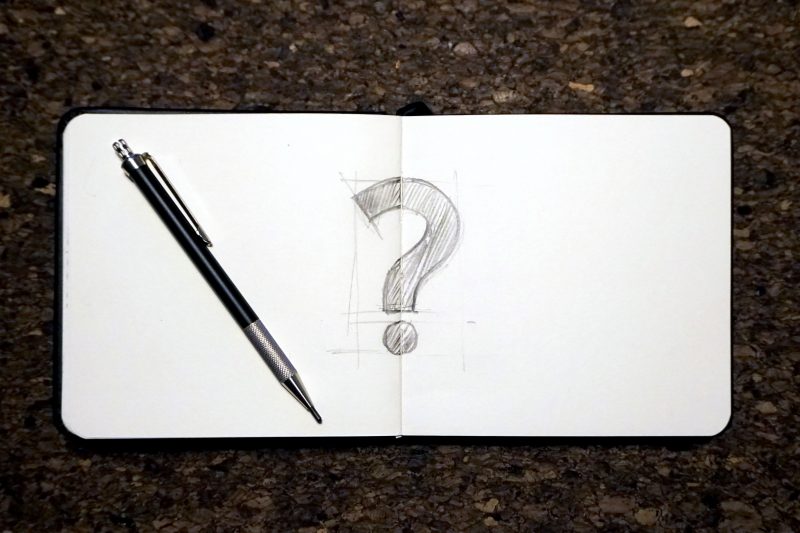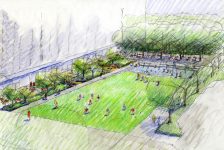“I wanted to start drawing again, but I just never seem to find time for it” is a sentence we regularly hear from our colleagues. Obviously, many people would like to draw. Maybe they have fond memories of their student years when they were using sketching for design much more often or hand-drawing might have even been on the curriculum. But we believe that drawing is still a very viable tool for every designer and it’s worth picking up again, even if you haven’t been doing it for years or you want to start from scratch.
Why draw?
Picking up anything new is always a challenge. One has to have reasons for it and a good amount of motivation. We’ve recently written on Land8 about the motivation for drawing in “3 Reasons Why You Should Start Drawing Now”.
Firstly, hand-drawing has recently experienced somewhat of a revival in the profession. Many entries in landscape architecture competitions have turned from realistic renderings towards more abstract visualizations, such as hand drawings and illustrations. These more abstract ways of visualization sometimes manage to catch the essence of a landscape architectural work better than a high-end rendering.
Secondly, drawing is an essential tool in the design process. It is the most simple and direct way to record a thought of the designer. But it’s even more than that. Sometimes, the drawing talks back to the designer, helping him or her better understand the shaping idea on the paper and develop it further.
Thirdly, it’s a way to analyze and observe the environment. Taking the time to carefully trace the lines of a view of the landscape forces us to think about its structure and building blocks, the relationship between them and ultimately understand it.
How to start drawing
We went through some reasons that we hope might motivate you to start drawing. But now what? Where to actually start? You have a sketchbook and a pen and now a blank page is staring at you? Well, let’s break the ice. We talk about how you can start in the following video:
A very important thing to note is that after breaking the ice, you have to create a habit if you want to stick to drawing. Here’s what you can do: we advise everyone that after starting, you come up with a plan or a challenge for yourself. Something like a sketch a day or drawing for half an hour every week. It’s best to start with small steps and work your way up slowly. Once you have established a habit, it’s not hard to expand on it and invest more time and energy if you want to.
The Basics of Drawing
The drawing is a process of recording your thoughts and observations on a 2-dimensional surface. It’s actually quite a complex task for our brains. It requires immense abstraction capabilities, for we are representing something 3-dimensional on a 2D surface. But don’t worry. Most of these complex mental processes are occurring subconsciously. All you have to do is observe, hold the pan and move your hand. Your brain and body do the rest. And as you practice, they get better and better at it.
Training your hand is a very good place to start. And the best way to do it is by repeating the basic building block of a drawing – the line. It’s like starting to learn to play a new instrument. You start by practicing single notes, not the whole of Bach’s Cello Suites, and merely train the coordination between your mind and your body. We suggest some basic exercises in the video How to Draw Lines:
When you’ve done several pages of lines and already feel like they torment you in your dreams, it’s probably time to move on. Once the hand has gotten somewhat accustomed to holding and moving the pen, it’s time to start observing our environment, thinking about it and recording it on paper. A good first step is drawing simple objects. They are easily understandable forms that are a great practice for your eye-brain-hand connection. When we draw them, we are forced to observe them, reinterpret them and then record them on paper. Need some good exercises to start drawing objects? We have just the video for you:
We’ve covered a lot of ground in this article and hope we’ll keep you busy for a while! In our next article, we’ll dive into 3D space, the actual subject of a landscape architects work. Meanwhile, if you are curious where to continue, you can always see more on our YouTube channel.
Before you go off drawing
We have a final tip for you. When learning something new, never compare yourself to others, compare yourself to you from yesterday. This won’t scare you away at the beginning and will still keep you going later once you have truly mastered it. Because you can always be better than yourself from yesterday.
Published in Blog, Cover Story, Featured




J. Robert (Bob) Wainner
IMO….”hand sketching & drawing” should begin as early as Jr. High & High School – that’s when I began. I continued sketching and improving my color rendering techniques while @ Texas A&M University. As I began my LA career back in 1977, I always believed that “hand sketching” was an important aspect of the “design process”. Of course, back then, there was no “autoCAD”. I was actually pretty surprised when in my 1st year at Texas A&M, that many of my classmates had never taken an Architectural Drafting course or Art Course before. Landscape Architecture was a natural choice for me over Architecture…as I believed it would be a more loose design profession where more “graphic skills” would be involved.
However, even in today’s world where computer drawing programs are often used…autoCAD, Sketchup, etc….”hand sketching” to develop preliminary design ideas, IMO, should always be used before utilizing autoCAD. For me, autoCAD came along well into my career…I never really had the time to learn autoCAD, so continued to produce all of my preliminary and final drawings “by hand”….still do at age 69. Never had a complaint from any of my clients over the years for not using autoCAD…and I have designed approx. 600 projects in 14 different States.
I have never really had a Web Site, per se, but, I have a FLICKR account with approx. 80 samples of my
design samples. If you would like to view my Portfolio….Google me @ J. Robert Wainner and look for my FLICKR web site.
I have always had a philosophy with my Landscape Architecture Career……”That GREAT designs must always be accompanied by GREAT graphics…..that you can’t separate the two”.
For my Design Projects, I have always believed that “hand drawn” Preliminary Designs & Color Rendered Graphics is actually in many ways, a better presentation format that using “computer generated” programs….as “hand drawngs/color renderings” is a more personal touch. IMO, our profession has become way too “computerized”. I have never regretted not learning autoCAD.
J. Robert (Bob) Wainner – Plano, Texas
Texas A&M University – Class of 1977
B.S.L.A. Degree in Landscape Architecture